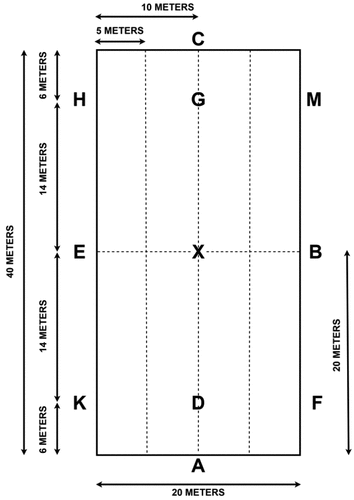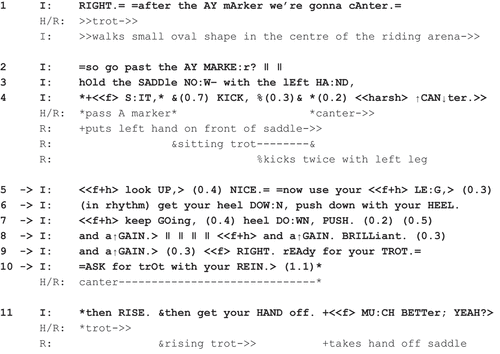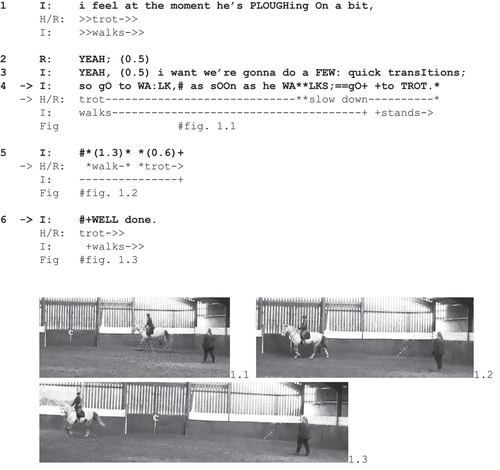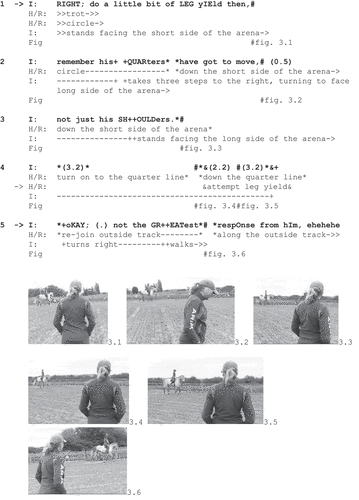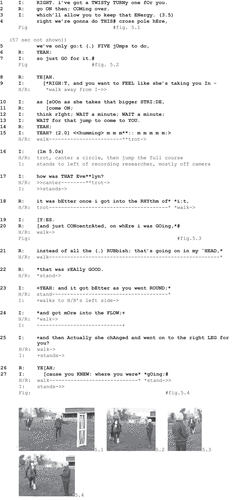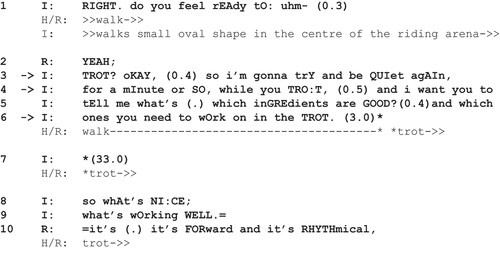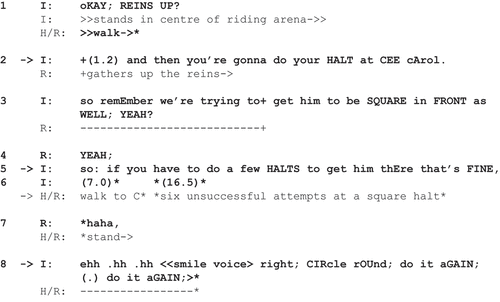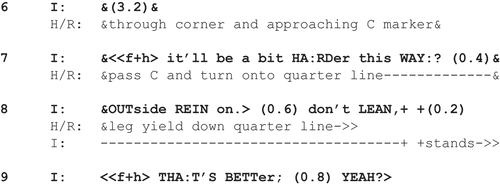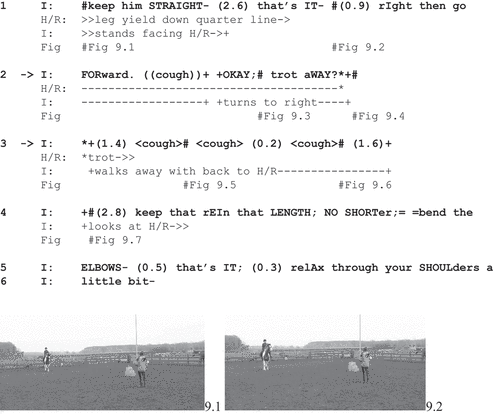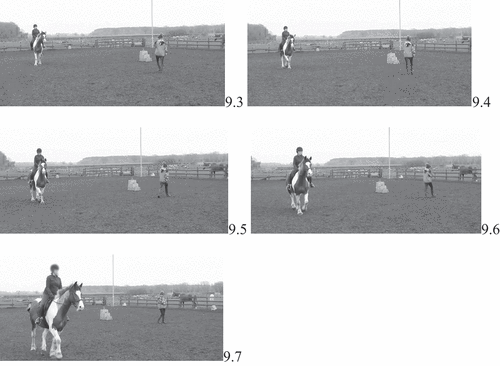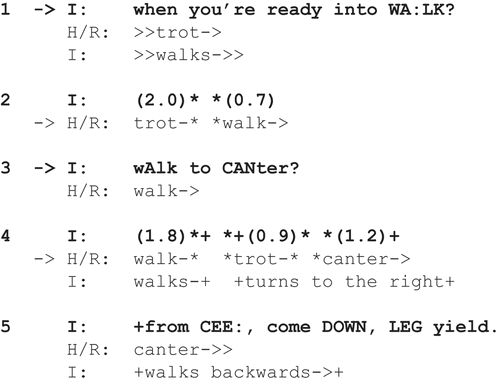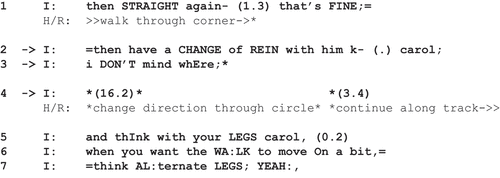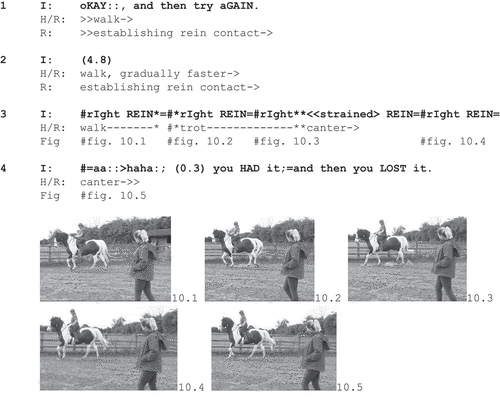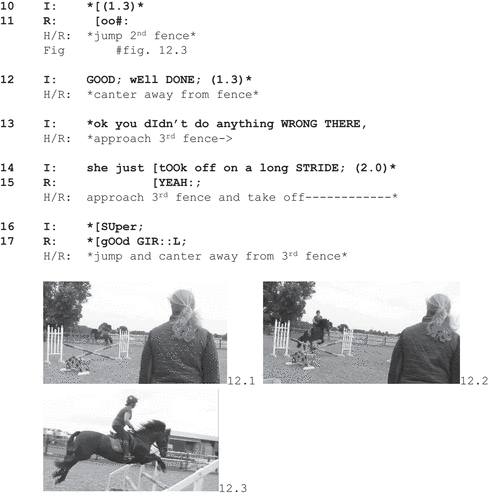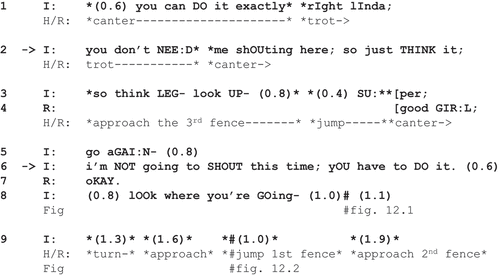ABSTRACT
The instruction of embodied skills often involves pair-like sequences consisting of an instructor’s directive to perform an embodied action and a learner’s (attempted) bodily performance of that action. This study explores the organization of such sequences in horse-riding lessons. Whereas in most of the studied data, learners’ performances of instructed actions are accompanied by continuing instructor talk, this study focuses on those rarer occasions when instructors observe learners in silence. The data show that silent observation often occurs at the beginning of an instructional sequence and also during instructed activities that are preparatory, operational, or otherwise not under evaluation. Instructors can abandon their initial silence when local events call for verbal support, showing that learners’ embodied actions are continuously susceptible to verbal commentary. In addition to silence, instructors also use embodied conduct to demarcate instruction and compliance and to position themselves as scrutinizing observers. The data are in British English.
Introduction
The study reported here is concerned with the instruction of an embodied skill, specifically with sequences during which instructors give a verbal directive to perform an embodied action, and learners respond by performing, or attempting to perform, that action. The focus is on instructors’ recipiency of learners’ complying actions. The context is horse-riding lessons. In the majority of instructional sequences, when instructors ask learners to perform an action, they follow this up with more talk on exactly how to perform the action and with feedback on how well the learners are doing. Their follow-up talk occurs while a learner is already performing the requested action. This results in a concurrent delivery of instructions and instructed actions. Concurrent instruction has been researched extensively in the conversation analytic literature. This study focuses on the rarer phenomenon of instructors’ silent observation of learners’ performances. By investigating instructor silence, the study contributes to a fuller understanding of embodied learning, communicative strategies for one-to-one coaching, and the role of speech and the body for instructional interaction.
The sequential organization of embodied skills instruction
In mundane talk-in-interaction, participants who have clearly allocated a turn to another participant typically relinquish their own turn and act as recipients of the other participant’s response. In many cases, this results in the original speaker’s silence, although practices for making continued verbal contributions exist (French & Local, Citation1983; Lerner, Citation1996; Sacks et al., Citation1974; Schegloff, Citation1982). Lerner (Citation1996) identifies the “semi-permeable” nature of turns by showing how potential next speakers orient to projected and unprojected opportunities to come in before a turn-in-progress is completed. This notion of the susceptibility of turns to co-construction by another participant can also be applied to what Stukenbrock (Citation2014) calls “multimodal adjacency pairs” (p. 82), in which first pair parts are verbal, and second pair parts are embodied and non-verbal. During the instruction of embodied skills, embodied responses appear to be permeable to co-construction by instruction givers.
Weeks (Citation1996) shows that multimodal instruction sequences can be organized in at least three ways. He distinguishes between the concurrent, interrupting, and subsequent placement of conductors’ corrective talk during orchestra rehearsals. Both subsequent and interrupting corrections—that is, corrections that are done after an instructed action has either been completed or has been brought to a temporary halt—are frequent in music-related settings, such as one-to-one music teaching (Tolins, Citation2013), music masterclasses (Szczepek Reed et al., Citation2013), and choir rehearsals (Emerson et al., Citation2017). Instructor talk can also run alongside learners’ embodied actions in a concurrent delivery. In addition to the orchestra rehearsals studied by Weeks (Citation1996), this has been described in instructional settings such as boxing (Okada, Citation2018), crocheting (Lindwall & Ekström, Citation2012), dancing (Ehmer, Citation2021), driving (De Stefani & Gazin, Citation2014), Pilates (Keevallik, Citation2020), rock-climbing (Simone & Galatolo, Citation2020, Citation2021), and horse-riding (Lundesjö Kvart & Melander Bowden, Citation2022).
Concurrently delivered instruction has received much attention, especially the temporal fittedness of instructor talk with emerging learner actions. Mondada’s (Citation2017) analysis of a race driving lesson shows how a “directive accompanies the directed action as it unfolds in real time, calibrating its length, intensity, changes, and completion” (Mondada, Citation2017, p. 91). Mondada’s work reveals the simultaneity of multimodal interaction and specifically how the coordination of instructions and instructed actions can result in “sequentially ordered simultaneities” (p. 91) of first and second pair parts. In their work on rock-climbing coaching for visually impaired climbers, Simone and Galatolo (Citation2020) identify “assistance instructions,” which are adjustments to initial instructions, “that are produced while the climber’s instructed action is unfolding … and are observably designed to support the climber in completing his/her ongoing movement” (p. 293). Along similar lines, Lundesjö Kvart and Melander Bowden (Citation2022) show that horse-riding instructors can teach “continuously … while the student rides,” which they refer to as “online instruction” (p. 294) through which instructors verbally “mold” (p. 297) the horse-rider pair. Embodied responses thus appear to be permeable to talk, as instructors can continue to treat learners’ response slots as open to ongoing verbal contributions. Against this background, this analysis explores sequences during which instructors observe embodied learner responses silently.
A small number of studies have considered instructors’ bodily positioning as observers of learners’ embodied performances, especially with regard to gaze. Stukenbrock (Citation2014) shows that when cooking instructors assess learners’ embodied actions, such as cutting a piece of meat, they can position their bodies in ways that allow for close observation. For example, they can stand very close to the learner, adjust their upper body orientation, and move their head in ways that allow optimal gaze access. Through such embodied adjustments they show that they are “not simply watching, but scrutinizing what [their] co-participant is doing” (p. 91, emphasis in the original). Nishizaka (Citation2022) describes lexical “repetition with a fixed gaze” (p. 25), which instructors use either to encourage the continuation of what a learner is doing or to bring a current activity to a halt. Nishizaka shows that repeating words or phrases while gazing intently at the learner’s emerging actions enacts close observation of the temporal development of an activity and allows instructors to attend to specific learners (out of a group) and their specific challenges. Nishizaka refers to this as “high-granularity seeing” (p. 24ff), which is distinct from “unmarked seeing” (p. 27) in that it addresses learners’ actions personally, not only publicly, and is sensitive to local features. These findings suggest that observation is something that instructors can enact (bodily or verbally) for learners to become and remain aware of, rather than something that is a straightforward result of gaze direction. The extracts below show that when instructors observe learners’ performances in silence, they enact ongoing scrutiny through their bodily actions.
The data for the study reported here are horse-riding lessons. Previous interaction-oriented research has detailed how the nuanced and mostly embodied communication between rider and horse is taught and learned (Lundesjö Kvart & Melander Bowden, Citation2022; Lundgren, Citation2020; Norris, Citation2012; Rettig, Citation2020). Some research has focused on riding instructors’ communicative practices (Lundgren, Citation2017; Szczepek Reed, Citation2023a), including their co-construction of an “instructional space” for individuals in group riding lessons (Lundesjö Kvart, Citation2020). The co-construction of temporality and mobility in riding lessons has been explored in Szczepek Reed (Citation2023b).
Data, methodology, and conceptual approach
The data for this study are 16 one-to-one horse-riding lessons that were recorded in England between March 2022 and March 2023. Individual lessons last between 18 and 48 minutes; the entire corpus is 9 hours 8 minutes in length, of which 8 hours and 46 minutes is active instruction time. Twelve recordings are of flat work (dressage) lessons, four are jumping lessons. Almost all dressage lessons took place in 20 × 40m riding arenas (). The jumping lessons took place in larger arenas of varying sizes.
Twenty-one riding coaches were approached with a request to film riding lessons. Eighteen were contacted through the online “Find a Coach” platform of the British Horse Society; three coaches were known to the researcher and were approached in person. Six coaches agreed to be recorded and sought preliminary consent from their clients. Once this was received, all participants gave formal written consent to be video recorded and for their anonymized data to be used and published for research purposes. All recordings are of different coach–horse-rider combinations except for one pair who were recorded first in a jumping and later in a flat lesson. Ethical approval for the study was given by King’s College London.
Transcripts follow GAT2 (Selting et al., Citation2009, 2011) for spoken interaction (see Appendix); however, in order to keep transcripts to a manageable size, intonation units are not allocated individual lines but are delimitated only by the punctuation marks that indicate phrase-final pitch (see Appendix). The transcription of embodied actions follows Mondada (Citation2018, Citation2019). Transcripts are limited to prosodic and embodied events that are relevant to the analysis. The audio and video recordings contain many events that are not shown in the transcripts.
A frequent phenomenon across the extracts is instructors’ reference to letter markers, which refer to conventionalized locations in the riding arena. shows a standard small dressage arena, where letters indicate specific locations. Ridden figures, such as circles and loops, are often ridden with reference to the letters. Instructors frequently refer to letters as indicators of where horse-rider pairs should start the next instructed action.
The study aligns with the conversation analytic research paradigm (Schegloff, Citation2007), in which analyses are based on participants’ observed interpretations of their own and others’ actions. An analytical challenge exists in that riders’ embodied actions are often not visible. Indeed, their observability and assessment are a “members’ problem” (Hutchby & Wooffitt, Citation2008, p. 50) as the invisibility of the riding aids is desired. In advanced riding instruction, instructors may therefore infer a rider’s influence on the horse from the horse’s movement. The analysis below is concerned only with what participants themselves make verbally relevant, acknowledging that some embodied actions remain unseen. In an attempt to represent horses’ key role in the activity of riding, transcripts and analyses refer to the horse-rider participant pair (H/R) when ridden actions are being discussed. In McIlvenny et al.’s (Citation2014, p. 105) terminology, the horse-rider pair is a “mobile formation.” When actions are clearly performed by either horse or rider individually, this is noted in the transcript and the text.
An important analytical tool for the analysis is the distinction between actions and activities. Activities consist of “multiple, normatively ordered sequences of action” (Robinson, Citation2012, p. 257), characterized by topical or goal-oriented coherence (Heritage & Sorjonen, Citation1994). Actions can therefore be components of activities, which themselves can be components of interactional “projects” with “an overall structural organization that involves multiple, ordered … activities” (Robinson, Citation2012, p. 267). The present study understands the riding lesson as an interactional project. Activities and actions are seen as participant categories and can be observed at varying degrees of granularity (see also Enfield & Sidnell, Citation2017, pp. 92–93). This means that events can be treated as actions in one sequence and as activities in another. For example, transitioning from trot to canter can be treated as the focus of a particular instruction sequence and be broken up into separate component actions. In a different sequence, it can be treated as a component action of, for example, jumping a course of fences. Therefore, the term activity is typically a better description of what horses and riders do than action.
Instructors’ recipiency of learners’ embodied activities
Instructors can share the response slot for learners’ embodied activities by filling it with talk, or they can hand it over by acting as silent observers. The two practices suggest a potential distinction between a concurrent and consecutive organization of instruction. However, such a contrast would imply a binary choice when, in fact, the organization of instructional sequences is emergent and, once begun, “not guaranteed” (Lerner, Citation1996, p. 257), as will be shown. Recent research has paid much attention to concurrently delivered instruction talk, especially its precise temporal organization and the affordances it brings (see above). Lines 5–10 in the following extract show concurrent instructor talk in the present corpus. The transcription symbol ǁ represents a lateral click (Ogden, Citation2020).
Extract 0. 20220425–1 Instructor A 2–03.54
Line 1 shows the initial directive. What follows is an extended cluster of follow-up directives and assessments delivered concurrently with the horse’s and rider’s complying actions.
Not talking while learners perform instructed embodied actions is comparatively rare in the present corpus. While the organization of instructions depends on local developments, instructors display a strong tendency toward talk. This can be shown in the amount of talk vs. silences overall, and in the number of directives that are followed by either talk or silence. shows both for each lesson and in total.
Table 1. Instructor talk vs. silence across the data set.
Time filled with talk much outweighs periods of silence, in each lesson and also in the corpus overall. For the purposes of this study, instructor silences are those lasting 2 seconds or longer, which allows for their differentiation from shorter pauses during ongoing talk. It also mitigates to some degree the over-representation of silences in this measure, which includes all silences, not only those that follow directives: The shortest period of silent observation in the corpus is 2.1s. Across all recordings, 78.6% of instruction time is filled with talk; 21.4% is silent. Individual lessons vary considerably, with a beginner lesson showing 96.3% talk (20220425–1, see ) and an advanced lesson (20220706) showing only 62.7%. Post-directive silences vary greatly in length, depending on the directive given and the time it takes horse and rider to perform them. For example, horse and rider may need to reach a certain location before they can perform the instructed action; or the directive may target a complex, extended activity. Also, instructors vary in how much they support learner actions through concurrent talk: The two beginner lessons in the corpus (20220425–1, 20220724–1) show a very high proportion of accompanying talk as instructors follow up on directives that in other lessons are observed silently or taken for granted in other ways (such as changes of direction). By comparison, in more advanced lessons, learners are sometimes (but not always) “left alone” more. Finally, duration and number of silences are influenced by individual instructors’ coaching styles. Instructor D stands out as observing silently more often than other coaches.
also shows the number of directives followed by either talk or silence. Directives followed by more talk only include initial directives, since follow-up talk typically includes more directives, which were not counted here (see lines 2–11 in ). For the purposes of this study, only first directives (such as line 1) were included. shows that initial directives followed by more talk outweigh directives followed by silence by 78% to 22%. Again, individual lessons show considerable variation, in terms of both proportion and actual numbers. A jumping lesson with an advanced horse-rider pair (20220425–2) shows 96.2% of directives with follow-up talk, whereas a flat lesson taught by Instructor D has the lowest proportion at 52.8% (20220706). In terms of actual numbers, the beginner lesson with the highest proportion of talk overall (see above) also shows the highest number of directives followed by more talk (88, 20220425–1); whereas an advanced jumping lesson (20230207) contains only seven initial directives followed by more talk. In that recording, the instructor speaks mostly during breaks, when they and the horse-rider pair are standing still (see ). This means that directives are being given in clusters and when horse and rider are not in a position to perform them immediately. Such directives have been referred to as “LATER directives” as opposed to “NOW directives” (Vine, Citation2004, pp. 32–33) and as “non-local” vs. “local action directives” (Szczepek Reed et al., Citation2013). Because the phenomenon studied here only applies to NOW directives, numbers are low for that recording. Numbers of directives can also depend on the riding discipline. Jumping lessons tend to contain fewer initial directives overall, because instructed activities can take longer than in flat lessons (e.g., jumping a course of fences vs. riding a circle). The jumping lesson in 20220724–2 is an outlier in this regard, as it starts with flat work before any jumping takes place.
The ratios presented here are strongly influenced by local contingencies that are different in each lesson. They demonstrate that instructor silence during learners’ performance of instructed embodied actions is the minority phenomenon compared to post-directive instruction talk. However, given that variables such as learners’ competence level, riding discipline, types of ridden exercises, and coaching style were not controlled for, the quantitative analysis must be taken only as a complementary background to the qualitative analysis below. In the following, silent observation will be explored in some depth—specifically, the activity types it accompanies, its temporal formats, its positioning in the larger instructional sequence, and its interactional and pedagogic affordances.
Silent observation of instructed activities: handing over the embodied response slot
Once a directive has been given, riding instructors can refrain from accompanying talk for the entire duration of the complying embodied activity. In doing so, they hand over the response slot for the performance of the instructed activity to horse-rider pairs. A scalar distinction can be made between shorter, comparatively simple instructed activities and longer, more complex ones. The following extracts are examples of varying duration and complexity.
Extract 1. 20220331 Instructor B 1–16.31
Extract 2. 20220330 Instructor B 1–8.55
(please see above and below) show instructions to perform local, comparatively instantaneous activities. In , the paired directive so go to walk as soon as he walks go to trot (line 4) is designed to address a local issue (lines 1–3). The transcribed section shows the first in a series of five such transition pairs trot–walk–trot. Transitions from one gait to another can be almost immediate or they can involve intermediate strides as the horse gradually slows down or speeds up. Here, the transition takes a few strides to come about fully, as the horse gradually slows down (line 4), which shows that the rider has complied with the first directive so go to walk. Line 5 shows the horse’s and rider’s compliance with the full instruction (transition from trot to walk followed by transition from walk to trot), during which the instructor remains silent. While talking, the instructor walks a small circle that mirrors the horse’s and rider’s bigger circle (Figure 1.1, lines 1–4). As she comes to the end of her verbal directives, she stops and stands, silently observing horse and rider as they perform the instructed transitions (Figure 1.2). Simultaneously with her closing assessment well done, which follows the successful completion of the requested actions, she resumes walking (Figure 1.3, line 6). The instructor’s vocal and embodied conduct thus treats the response as sequentially separate from her own verbal contributions.
is part of the warm-up, which typically includes frequent transitions from one gait to another. Horse and rider comply with the directives to trot (line 1) and then walk (line 3), continuing in the respective actions as instructed until a next directive is given. The instructor remains silent as the directives are being complied with and continues to observe horse and rider silently, turning her body steadily on the spot in alignment with the circling horse-rider pair. In contrast to , this extract shows the last two in a series of 12 instructed transitions of the same kind. The instructor’s silent observation thus occurs at a late point in sequence when the task has already been performed repeatedly.
shows another first iteration of an exercise that will later be performed repeatedly. This time, horse and rider struggle to perform the requested activity. The directive do a little bit of leg yield then (line 1) requires them to come down the quarter line—that is, a parallel line running five meters in from the outside track (see )—and return to the track with the horse’s legs crossing laterally. The instructor adopts a position from which she can observe the long side of the arena (Figures 3.1–3.3, lines 1–3) and stands in a quasi-immobile stance while the instructed action is being performed (Figures 3.4–3.5, line 4). During the attempted leg yield, the horse’s legs cross only minimally, and he trots back to the track in an almost straight line. The instructor remains silent throughout, but as soon as horse and rider approach the outside track, she delivers a negative assessment and starts walking with them (Figure 3.6, line 5)
Extract 3. 20220527 Instructor C1–8.19
Typically, when horses and riders struggle to accomplish instructed actions, instructors in this corpus give corrections straight away and while the activity is being performed. In the above case, the instructor withholds this kind of verbal support. A possible explanation lies in the position of this sequence as the first of several iterations of the exercise. Handing over the slot for the embodied activity entirely to the learner provides the instructor with an opportunity to identify learnables that can be made relevant during subsequent iterations.
also shows an unsuccessful attempt at an instructed activity.
Extract 4. 20220329 Instructor A 2–6.16
The instructor asks the rider to bring about a halt “at C”, a marker on the short side of the arena (see ), and to allow for more than one attempt if necessary (line 5). Her specific instruction for the horse to be square in front (line 3) refers to his front legs being positioned in parallel when standing still. The instructor’s early announcement that horse and rider might need more than one attempt frames multiple attempts as likely and permissible, thereby creating a projection that unsuccessful attempts may not be corrected. When the rider brings the horse to a halt at the C marker, the horse indeed does not stand square but has his front left leg too far forward. The rider asks him to take a single step forward with the result that the horse places his right leg in front, again not standing “square.” This repeats six times, as the horse gradually edges ever further forward, never standing with his legs in parallel (line 6). The sixth unsuccessful attempt is met with laughter from the rider (line 7) and responsive laughter from the instructor, who gives the directive to abort the task and try again (line 8). Throughout these attempts, the instructor stands in the middle of the arena and observes in silence. Her early projection of likely challenges means that correcting unsuccessful attempts when they occur would be incongruent with her own framing of the exercise. In this case, a certain leeway regarding how to perform the task has been built into the directive. This extract also shows the first iteration of an exercise, which is repeated once more, this time successfully.
Silent observation can also accompany longer, more complex activities. shows the silent observation of an entire sustained embodied activity (Szczepek Reed, Citation2023b)—that is, a coherent sequence of actions that requires ongoing embodied effort. The extract comes from a jumping lesson and shows a horse-rider pair jumping a course of five fences.
Extract 5. 20230207 Instructor F 1–9.43
Lines 1–4 show the beginning of an extended instructor turn that asks the rider to jump the course in a certain order of fences. During an omitted stretch of 57 seconds (line 4), instructor and rider jointly work out the order of the jumps and the instructor gives advice on how to ride the course. Throughout this period, horse and instructor are standing, with the instructor positioned to the left of the horse-rider pair (Figure 5.2, line 7). As the instruction turn is approaching completion, horse and rider walk away (line 9). The instructor continues to give instructions for a short while (lines 9–15) but then hums to herself (line 15), making herself vocally unavailable for further talk. In the subsequent 1 minute 5 seconds, horse and rider jump the full course of fences. During this time, the instructor stands to the left and slightly behind the recording researcher and is mostly off camera. She is silent throughout. Once the rider has jumped the last fence and canters away from it, the instructor initiates an evaluation sequence (line 17) which closes the [verbal directive–embodied response] sequence. As the rider responds verbally, horse and rider approach the instructor (Figure 5.3, line 20) and come to stand near her (lines 17–22), with the instructor positioned to their right. As the instructor starts to respond, she walks to the other side of the horse-rider pair, positioning herself to their left (lines 23–24). The rider also asks her horse to walk nearer to the instructor (lines 24–27) until the participants have reached positions very similar to the ones they occupied prior to the exercise (compare Figures 5.2 and 5.4). From these embodied stances they engage in further instructional interaction lasting 1 minute 35 seconds before the next iteration of jumping the course.
comes from a recording in which instruction is mostly delivered during breaks and in clusters of non-local LATER directives (see above). This organization is also found in music masterclasses (Szczepek Reed et al., Citation2013), where instructional interaction and learner performance are typically organized into separate slots, with participants moving in and out of the engagement space accordingly (Reed & Szczepek Reed, Citation2013). Similarly, the participants in co-construct the consecutive delivery of verbal instruction and learner performance through their embodied conduct: during pre- and post-performance instruction, the participants stand in close proximity and in the same position. However, instruction and compliance are achieved gradually, and their boundaries are flexible, as instructor talk overlaps with the beginning and end of the instructed performance (Mondada, Citation2021) and with the participants’ embodied positioning.
Instructor silence can also be framed explicitly as a strategic pedagogical practice, as in the following extract.
Extract 6. 20220605–1 Instructor D 1–10.00
The extract differs from previous examples in that the directive not only targets an embodied activity as such but also the rider’s self-evaluation. Thus, the instructor hands over the compliance slot not only for embodied performance but also for performance assessment, giving the learner additional responsibility (see also Smith & Cushion, Citation2006). Once again, the instructor’s silence accompanies the first iteration of the requested task, as this is the first time in the lesson that horse and rider are being asked to trot.
The above extracts are representative of a frequent pattern in the data set. When instructors ask horse-rider pairs to perform tasks repeatedly, silent observation often occurs either at the beginning or, in some cases, at the end of such a series. Handing over the first performance slot to learners allows instructors to assess the overall quality of an exercise and identify learnables for subsequent iterations. Silence late in the instruction sequence allows learners to put earlier instructions into practice without instructors’ verbal intervention. This confirms findings by Deppermann (Citation2018), who shows that instructions can decrease in complexity when repeated over time and can even be “mostly rehearsed in silence” (p. 317), which Deppermann links to instructors’ treatment of learners as increasingly competent. shows that silent observation can also be the result of how the directive has been framed: If instructors give learners verbal leeway for several attempts, then criticizing early unsuccessful attempts is incongruent with that framing. All of the extracts show that silent observation contributes to a consecutive organization of instruction and instructed performance, alongside participants’ embodied orientation and positioning.
Silence during preparatory or operational instructed activities: Designing embodied responses as not under evaluation
Instructors can silently observe actions that, although requested, are not the current focus of instruction. This may have been made apparent by earlier talk, or the silent observation itself may co-construct requested actions in this way. In the following extract, two instructed preparatory tasks lead up to a target exercise. Four minutes prior to the transcribed section, the instructor introduces the next exercise as “leg yield in canter,” which is received with a surprised response by the rider (“oo:; wo:w; okay,”). This may indicate that this is the first time she has ridden this exercise or that it a rare occurrence. The instructor explains that in the run-up to the exercise, horse and rider will do a trot-to-walk transition, followed by a transition from walk to canter. The first iteration of the full exercise is accompanied by concurrent instruction talk (data not shown). The transcribed section shows the second iteration of the full exercise.
Extract 7. 20230228 Instructor F 2–9.54
The instructor observes silently the horse’s and rider’s compliance with her directives to transition from trot to walk (lines 1–2) and from walk to canter (lines 3–4). She does not provide third position assessments. As the horse-rider pair perform the first instructed action, the trot-walk transition, she continues to walk with them. In parallel with the second action, the walk to canter, she turns her body to the right and walks backwards in preparation for the target exercise, the leg yield in canter, which she will observe from a position further back in the riding arena (lines 4–8). As soon as horse and rider begin performing the targeted task, the instructor accompanies this with verbal instruction: As the pair reach the C marker, which has been identified as the location from which to start the leg yield (line 5), she gives a prefacing instruction (line 7). While horse and rider perform the leg yield down the quarter line, she gives concurrent directives and assessments (lines 8–9).
The extract shows silent observation of actions that have been explicitly framed as preparatory to the main exercise. Additionally, these actions are not verbally evaluated, and the instructor’s embodied positioning remains mobile, orienting to the targeted final action. The fact that the silent observation co-occurs with a second iteration of a repeated activity is noteworthy, as many other silences in the corpus accompany first iterations. The rider’s treatment of the exercise as potentially new, and the complex nature of the exercise itself may explain why the instructor provides concurrent support during the first iteration. By the time the exercise is being performed for the second time, the preparatory nature of the first two movements is treated as established and receives no more verbal support or evaluation.
The next extract shows silent observation of an operational, rather than a task-related requested action. Immediately prior to the transcribed section, the instructor has asked the rider to flex the horse’s neck left and right, which is a warming-up exercise.
Extract 8. 20220329 Instructor A 1–1.03
Following the directive to keep the horse’s neck straight again after flexing it (line 1), the instructor requests a change of direction (“change of rein”; lines 2–3). She verbally frames the request as unrelated to the current instructional focus by giving the rider freedom to choose where to perform the change of direction, which, due to the positioning of different riding figures, also affects how the change will be ridden and how long it will take. The instructor observes silently for 19.6s as horse and rider leave the track to ride through the middle of the circle and turn the other way at the other end (line 4). She resumes her instructional talk only when horse and rider have been walking in the new direction for approximately 3 seconds (lines 5–7), focusing not on the change of direction but on how the rider should use her legs during walk. The instructor frames the silently observed activity as not under evaluation by expressing an agnostic stance toward where and how the operational task of changing direction should be ridden.
In and , silent observation accompanies actions that have been verbally constructed as not in the pedagogical focus. In the following extract, it is only the instructor’s silence and her embodied conduct that construct the horse-rider pair’s action as not currently under scrutiny. At the start of the transcribed section, they are performing an instructed task, a leg yield in walk.
Extract 9. 20220329 Instructor A 1–2.48
The instructor stands facing the horse-rider pair, giving concurrent instructions as they come down the quarter line of the arena in leg yield (Figures 9.1 and 9.2). Her closing directive right then go forward (lines 1–2), asking the horse and rider to walk straight rather than laterally, is not complied with, as horse and rider continue to leg yield; however, this receives no uptake from the instructor. Upon completion of her transitional okay (Mondada & Sorjonen, Citation2021), the instructor begins to turn to the right, away from the horse-rider pair (Figure 9.3). While doing so, she gives a new directive trot away (line 2), after which she turns her back fully on horse and rider and walks away to the right (Figures 9.4–9.6), not seeing the transition to trot and closing the local instruction sequence (Broth & Mondada, Citation2013). Her embodied positioning as not looking at horse and rider begins with her transition away from the previous instructed action and continues through the delivery of the new directive. 1.4s into walking away, she also coughs three times (line 3), making herself vocally unavailable for verbal instruction. 1.6s after the final cough she turns her gaze back to horse and rider (Figure 9.7). The entire sequence of directive and complying embodied action is done while the instructor makes herself unavailable for enacted scrutiny. Soon after her bodily turn back toward horse and rider, she resumes concurrent instruction talk (lines 4–6). The extract shows a moment of disengagement from the instructional interaction, as the transition from walk to trot is treated as purely operational and not under evaluation. A related phenomenon is described in Partington and Cushion (Citation2013), whose analysis of soccer coaching behaviors distinguishes between “on task” and “off task” silences, with “off task” silence referring to “coach is visibly not engaged in the practice” (p. 376).
Breaking the silence: the permeable embodied response
Instructor silence during a learner’s performance of an instructed embodied activity is precarious, as instructors routinely treat embodied performances as permeable to continued verbal contributions. In the majority of [verbal directive–embodied response] sequences in the data set, instructors continue to talk while learners comply with instructions, thus sharing the activity with the allocated responders. Even when instructors remain silent initially, their recipiency emerges with learners’ instructed actions and is contingent on them. For example, they may start out with silent observation during the initial phases of an instructed action but support learners verbally later on. Concurrent instruction talk can also be contingent on sudden trouble or correctable actions. The following extracts show instructed embodied activities that are partially observed in silence but are permeated by instructor talk when corrections, reassurance, or other contributions become relevant. In the first case, the instructor observes silently while horse and rider are preparing to perform the requested action and comes in to support them verbally when they are eventually attempting to perform it. Prior to the transcribed section, the horse-rider pair have been asked repeatedly to transition from walk to trot; however, the horse has instead transitioned to canter on each occasion.
The instructor observes silently for 4.8 seconds as the rider prepares for the transition and tries to establish a connection with the horse through the reins (lines 1–2). As the horse gradually walks faster and the transition becomes imminent, the instructor gives the directive right rein four times. The outside rein (here, the right rein) is used for a variety of reasons, including to balance the horse in preparation for a transition and to control his or her speed, energy, and rhythm. The onset of the directives is fitted to the moment when horse and rider are about to perform the instructed transition (Figure 10.1). The horse takes a few strides in trot (Figures 10.2–10.3) but then transitions to canter (Figures 10.4–10.5). During the third and fourth iteration of right rein, the instructor’s voice becomes strained, ending in the strained vocalization aa:: (lines 3–4) and co-occurring with the horse’s undesired transition to canter. The instructor accompanies and supports the rider at exactly the moment when the problematic activity is to be performed. In doing so, she co-constructs the overall timeframe of the instructed action in real time (see also Mondada, Citation2017, pp. 89–91; Simone & Galatolo, Citation2021). Throughout the sequence, the instructor walks a small circle, mirroring the bigger circle that the horse and rider are on and participating in their mobility.
Similarly, in , the instructor observes the run up to an instructed activity in silence before giving verbal instructions when the activity is being performed.
Extract 10. 20220706 Instructor D 2–4.15
The directive is to transition to canter in the A-F corner and canter down the long side, coming back to trot after M (see the dressage arena diagram in ). After a brief pause, the instructor gives a single preparatory directive (line 6). This is followed by a period of silent observation lasting just over 10 seconds, as horse and rider trot down the long side of the arena and toward the specified location of the instructed action. Just before they reach the A marker, the instructor gives step-by-step instructions (Rauniomaa et al., Citation2018) on how to perform the instructed action: sit now (0.3) give him the aids (0.2) go (line 7). When the transition is not accomplished straight away, additional follow-up instruction is given (line 8). As horse and rider canter down the long side as requested, the instructor continues with concurrent instruction before initiating the closing of the exercise (line 10).
and show that silent observation can co-construct instructed actions as preparing for or running up to the target exercise as horse and rider are given time to get ready for the requested action. Just as they are about to perform the requested actions, instructors can begin to deliver concurrent instructions. Silence can also be abandoned due to unforeseen events. In the following extract, the instructor announces that she will remain silent during the upcoming instructed activity; however, local contingencies mean that she does end up making verbal contributions. At the start of the transcribed section, horse and rider are finishing a course of three fences and are then asked to go again (line 5).
Extract 11. 20230327 Instructor A 1–19.07
As horse and rider prepare for the last fence of the first round of jumps, the instructor refers to her own concurrent instruction talk (line 2). By contrasting her “shouting” with the rider’s “thinking it” she verbalizes an aimed-for transition to learner independence. Similarly, her announcement I’m not going to shout this time you have to do it (line 6) instructs the learner to perform the activity autonomously, without her commentary. However, almost immediately after making this announcement, she delivers the corrective look where you’re going (line 8). The horse-rider pair are off camera at this moment, but it is likely that the comment refers to the rider’s head position. The instructor remains silent as horse and rider approach the first fence (Figure 12.1), jump it (Figure 12.2), and ride away from it toward the second fence (line 9). For the second fence, the horse takes off slightly early, which results in a long jump (Figure 12.3). As they jump the fence, the rider produces the nonlexical vocalization oo: (line 11), likely treating the long jump as a source of concern. The instructor responds with a positive assessment and reassurance (lines 12–14). The extract shows that the organization of instructional sequences is interactionally managed. Although this instructor expresses the intention of remaining silent during the horse’s and rider’s performance, she nevertheless fits her verbal conduct to emerging interactional contingencies. These include the need to correct the rider’s bodily position and the need to respond to her vocal expression of anxiety.
The instructor’s account for her silence—I’m not going to shout this time you have to do it—contrasts instructors’ “shouting” with learners’ “doing.” It reveals concurrent instructor commentary as a practice for supporting the learner in the ongoing activity and for accomplishing certain aspects of the performance on the learner’s behalf (see also Szczepek Reed, Citation2023a). Verbal sharing of the turn space allows instructors to continuously fine-tune embodied responses in contexts where “hands-on” manipulation is not possible. Simone’s and Galatolo’s (Citation2020) study of instruction for visually impaired rock-climbers describes “assistance instructions” (p. 294) that guide an unseeing participant to the correct locations for their hands or feet. Lundesjö Kvart and Melander Bowden (Citation2022) describe riding instructors’ “molding” of learners’ embodied actions as they occur (p. 297).
show how instructor silence during the performance of an instructed activity can be abandoned when instructors treat emerging learner actions as requiring correction or reassurance. In and , silent observation co-constructs the activities it accompanies as running up to the target exercise, as instructors support only the actual execution of the requested task with verbal contributions. In , local contingencies lead the instructor to abandon an earlier commitment to remain silent when the learner’s vocal and embodied responses require intervention. The extracts show that instructors can relinquish or pick up spoken turns at any relevant opportunity, as instructed embodied activities—when performed silently—appear to be fully permeable.
Extract 12. 20220724–2 Instructor E 3–3.09
Summary and discussion
The majority of instructed actions and activities in the present corpus are accompanied by concurrent instruction talk. It is rare for instructors to watch learners in silence. There appears to be a tendency for silence to occur during the first performance in a string of repetitions; however, the data suggest a preference rather than a norm. Silent observation can also be found in other positions, including during final performances and during instructed actions that are not part of a series. Remaining silent during a first performance allows instructors to identify learnables for upcoming instruction, including when attempts at the instructed action are unsuccessful. Silence during later performances gives learners the opportunity to put into practice instructors’ earlier advice on the same embodied task. In both positions, instructor silences contribute to a “test mode” (Michal Marmorstein, personal communication)—that is, a moment of silent scrutiny rather than of active “molding” (Lundesjö Kvart & Melander Bowden, Citation2022, p. 297). Instructors may verbally project or announce periods of silence, and they can make themselves vocally unavailable, such as through coughing or humming to themselves. Silences can accompany embodied responses that are comparatively brief, containing local and instantaneous actions, but also sustained and complex activities. In addition to placing performances under tacit scrutiny, silence can co-construct instructed actions as preparatory, operational, or otherwise not in the pedagogical focus.
By refraining from continuing talk once a directive has been given, instructors treat the response as separate from and subsequent to their own contribution. In addition to vocal silence, instructors also demarcate their instructions from learners’ responses through embodied actions by adopting positions of scrutiny (Nishizaka, Citation2022; Stukenbrock, Citation2014). By walking with the horse-rider pair, they can show themselves to be sharing and participating in the mobile formation (McIlvenny et al., Citation2014). By walking while instructing and stopping while observing, they can design their instruction and learners’ embodied responses as separate, and themselves as static observers. By positioning themselves at a central location from which they can observe the embodied performance, they can foreground their scrutinizing gaze and verbal contributions while designing their other embodied actions as minimal vis-à-vis the embodied actions of the horse-rider pair. By returning to pre-response embodied positions, they can frame the embodied response as subsequent to instruction talk. The interactional achievement of this organization emerges from the contingencies of each individual sequence, and instructors may break their silence at any moment. Initial silences during the preparation or run up to an instructed action can be abandoned for concurrent instruction once the target action is being performed. Instructors can also abandon earlier commitments to remain silent when local events call for a verbal intervention.
The present analysis distinguishes between consecutive and concurrent organization of instruction sequences. Both come with interactional affordances. In consecutively delivered instruction sequences, where learners’ performance is silently observed in full, initial instructions are treated as sufficient, complete, and not requiring further specification. Learners’ performance of an instructed activity remains undisturbed. This organization allows both participants to perform their respective actions self-reliantly, without the need to adapt them to ongoing contributions by the other. In contrast, concurrent talk allows instructors to expand on their directives when emerging learner actions require it, supporting learners in their performance of the instructed action (Simone & Galatolo, Citation2020). It also allows learners to improve their performance in real time.
It is not entirely surprising that silent observation is comparatively rare in the corpus. An earlier study by this author and colleagues on music masterclasses (Szczepek Reed et al., Citation2013) showed that in a setting in which consecutive rather than concurrent delivery is the norm, instructors also orient to extensive verbal contributions. Here, too, only the first iteration of a musical piece is typically received in full. From then onward, instructors frequently interrupt learners’ musical performances with long “clusters of directives” (p. 26) and other instructional talk, leaving little room for compliance, practice, and learner autonomy (see also Szczepek Reed, Citation2017). It appears that in both contexts, instructors show a preference for making verbal contributions over providing undisturbed room for compliance and practice.
The preference for making verbal contributions while a responder is performing a requested embodied action may have at its roots a human language bias, and a resulting orientation to speech as a default mode of communication. Further, instructors’ preference for talk may be related to a reluctance to look at others over long periods of time, orienting to a social norm that it is “rude to stare.” Such a reluctance has been shown, for example, during eating, when humans appear to avoid gazing at others while they are taking a bite (Wu et al., Citation2014). However, the institution-specific goals, inferences, and contribution types (Heritage & Clayman, Citation2010, pp. 34–35) of co-present embodied skills instruction include as a defining element the scrutinizing observation of learners by the instructor, making such a reluctance unlikely.
The literature on team sports coaching suggests that silence can be a deliberate pedagogic strategy. Smith and Cushion (Citation2006) find that some youth soccer coaches are concerned that “too much [verbal] intervention would deny the players not only opportunities to learn but also the opportunity to demonstrate what has all ready (sic) been learnt” (p. 361). However, a different study by Partington et al. (Citation2014) suggest that not all soccer coaches use silence strategically (“I am silent because I have nothing to coach,” p. 411). It could also be that in a context in which learners are paying for expert support, an absence of talk is treated as a failure to meet client expectations. Irrespective of extra-interactional explanations for why instructors prefer talk over silence, the interactional outcome of silent observation is the opening up of a space for embodied practice that is allocated exclusively to the learner.
Disclosure statement
No potential conflict of interest was reported by the author.
References
- Broth, M., & Mondada, L. (2013). Walking away: The embodied achievement of activity closings in mobile interaction. Journal of Pragmatics, 47(1), 41–58. https://doi.org/10.1016/j.pragma.2012.11.016
- De Stefani, E., & Gazin, A.-D. (2014). Instructional sequences in driving lessons: Mobile participants and the temporal and sequential organization of actions. Journal of Pragmatics, 65, 63–79. https://doi.org/10.1016/j.pragma.2013.08.020
- Deppermann, A. (2018). Changes in turn-design over interactional histories: The case of instructions in driving school lessons. In A. Deppermann & J. Streeck (Eds.), Time in embodied interaction: Synchronicity and sequentiality of multimodal resources (pp. 293–324). Benjamins.
- Ehmer, O. (2021). Synchronization in demonstrations. Multimodal practices for instructing body knowledge. Linguistics Vanguard, 7(s4), 20200038. https://doi.org/10.1515/lingvan-2020-0038
- Emerson, K., Williamson, V., & Wilkinson, R. (2017). Once more, with feeling: Conductors’ use of assessments and directives to provide feedback in choir rehearsals. Musicae Scientiae, 23(3), 362–382. https://doi.org/10.1177/1029864919844810
- Enfield, N. J., & Sidnell, J. (2017). The concept of action. Cambridge University Press.
- French, P., & Local, J. (1983). Turn-competitive incomings. Journal of Pragmatics, 7(1), 17–38. https://doi.org/10.1016/0378-2166(83)90147-9
- Heritage, J., & Clayman, S. (2010). Talk in action. Interactions, identities, and institutions. Wiley-Blackwell.
- Heritage, J., & Sorjonen, M.-L. (1994). Constituting and maintaining activities across sequences: And-prefacing as a feature of question design. Language in Society, 23(1), 1–29. https://doi.org/10.1017/S0047404500017656
- Hutchby, I., & Wooffitt, R. (2008). Conversation Analysis (2nd) ed.). Polity Press.
- Keevallik, L. (2020). Linguistic structures emerging in the synchronization of a pilates class. In C. Taleghani-Nikazm, E. Betz, & P. Golato (Eds.), Mobilizing others: Grammar and lexis within larger activities (pp. 147–173). Benjamins.
- Lerner, G. H. (1996). On the “semi-permeable” character of grammatical units in conversation: Conditional entry into the turn space of another speaker. In E. Ochs, E. A. Schegloff, & S. A. Thompson (Eds.), Interaction and Grammar (pp. 238–276). Cambridge University Press.
- Lindwall, O., & Ekström, A. (2012). Instruction-in-interaction: The teaching and learning of a manual skill. Human Studies, 35(1), 27–49. https://doi.org/10.1007/s10746-012-9213-5
- Lundesjö Kvart, S. (2020). Instructions in horseback riding - the collaborative achievement of an instructional space. Learning, Culture and Social Interaction, 25, 100253. https://doi.org/10.1016/j.lcsi.2018.10.002
- Lundesjö Kvart, S., & Melander Bowden, H. (2022). Instructing equestrian feel: On the art of teaching embodied knowledge. Scandinavian Journal of Educational Research, 66(2), 290–305. https://doi.org/10.1080/00313831.2020.1869076
- Lundgren, C. (2017). Ridtränares kommunikation under privatlektioner i dressyr: En samtalsanalytisk studie [The communication of trainers in equestrian dressage: A multimodal interaction analysis]. Scandinavian Sport Studies Forum, 8, 67–86. https://sportstudies.org/2017/09/15/ridtranares-kommunikation-under-privatlektioner-i-dressyr-en-samtalsanalytisk-studie/
- Lundgren, C. (2020). What do trainers teach their riders about horses and riding? An interaction analysis study of sports dressage training. In J. Bornemark, P. Andersson, & U. E. von Essen (Eds.), Equine cultures in transition (pp. 342–362). Routledge.
- McIlvenny, P., Broth, M., & Haddington, P. (2014). Moving together: Mobile formations in interaction. Editorial to the Special Issue. Space and Culture, 17(2), 104–106. https://doi.org/10.1177/1206331213508679
- Mondada, L. (2017). Precision timing and timed embeddedness of imperatives in embodied courses of action. In M.-L. Sorjonen, L. Raevaara, & E. Couper-Kuhlen (Eds.), Imperative turns at talk: The design of directives in action (pp. 65–101). Benjamins.
- Mondada, L. (2018). Multiple temporalities of language and body in interaction: Challenges for transcribing multimodality. Research on Language and Social Interaction, 51(1), 85–106. https://doi.org/10.1080/08351813.2018.1413878
- Mondada, L. (2019). Conventions for multimodal transcriptions. Version 5.0.1. Retrieved August 23, 2023, from https://www.lorenzamondada.net/multimodal-transcriptionLast
- Mondada, L. (2021). How early can embodied responses be? Issues in time and sequentiality. Discourse Processes, 58(4), 397–418. https://doi.org/10.1080/0163853X.2020.1871561
- Mondada, L., & Sorjonen, M.-L. (2021). OKAY in closings and transitions. In E. Betz, A. Deppermann, L. Mondada, & M. L. Sorjonen (Eds.), OKAY across languages: Toward a comparative approach to its use in talk-in-interaction (pp. 94–127). Benjamins.
- Nishizaka, A. (2022). The granularity of seeing in interaction. Journal of Pragmatics, 190, 24–40. https://doi.org/10.1016/j.pragma.2021.12.016
- Norris, S. (2012). Teaching touch/response-feel. A first step to an analysis of touch from an (inter)active perspective. In S. Norris (Ed.), Multimodality in practice: Investigating theory-in-practice-through-methodology (pp. 7–19). Routledge.
- Ogden, R. (2020). Audibly not saying something with clicks. Research on Language and Social Interaction, 53(1), 66–89. https://doi.org/10.1080/08351813.2020.1712960
- Okada, M. (2018). Imperative actions in boxing sparring sessions. Research on Language and Social Interaction, 51(1), 67–84. https://doi.org/10.1080/08351813.2017.1375798
- Partington, M., & Cushion, C. (2013). An investigation of the practice activities and coaching behaviors of professional top-level youth soccer coaches. Scandinavian Journal of Medicine and Science in Sports, 23(3), 374–382. https://doi.org/10.1111/j.1600-0838.2011.01383.x
- Partington, M., Cushion, C., & Harvey, S. (2014). An investigation of the effect of athletes’ age on the coaching behaviours of professional top-level youth soccer coaches. Journal of Sports Sciences, 32(5), 403–414. https://doi.org/10.1080/02640414.2013.835063
- Rauniomaa, M., Haddington, P., Melander, H., Gazin, A.-D., Broth, M., Cromdal, J., Levin, L., & McIlvenny, P. (2018). Parsing tasks for the mobile novice in real time: Orientation to the learner’s actions and to spatial and temproal constraints in instructing-on-the-move. Journal of Pragmatics, 128, 30–52. https://doi.org/10.1016/j.pragma.2018.01.005
- Reed, D. J., & Szczepek Reed, B. (2013). Building an instructional project: Actions as components of music masterclasses. In B. S. Reed & G. Raymond (Eds.), Units of talk – Units of action (pp. 313–341). Benjamins.
- Rettig, H. (2020). Praktiken des Empathisierens in Reitunterricht und Pferdeausbildung. In K. Jacob, K.-P. Konerding, & W.-A. Liebert (Eds.), Sprache und Empathie (pp. 285–332). de Gruyter.
- Robinson, J. D. (2012). Overall structural organization. In J. Sidnell & T. Stivers (Eds.), The handbook of conversation analysis (pp. 257–280). Wiley-Blackwell.
- Sacks, H., Schegloff, E. A., & Jefferson, G. (1974). A simplest systematics for the organization of turn-taking for conversation. Language, 50(4), 696–735. https://doi.org/10.1353/lan.1974.0010
- Schegloff, E. A. (1982). Discourse as an interactional achievement: Some uses of ‘uh huh’ and other things that come between sentences. In D. Tannen (Ed.), Analyzing discourse: Text and talk (pp. 71–93). Georgetown University Press.
- Schegloff, E. A. (2007). Sequence organization in interaction: A primer in conversation analysis. Cambridge University Press.
- Selting, M. (2007). Lists as embedded structures and the prosody of list construction as an interactional resource. Journal of Pragmatics, 39(3), 483–526. https://doi.org/10.1016/j.pragma.2006.07.008
- Selting, M., Auer, P., Barth-Weingarten, D., Bergmann, J., Bergmann, P., Birkner, K., Couper-Kuhlen, E., Deppermann, A., Gilles, P., Günthner, S., Hartung, M., Kern, F., Mertzlufft, C., Meyer, C., Morek, M., Oberzaucher, F., Peters, J., Quasthoff, U., Schütte, W., & Uhmann, S. (2009). Gesprächsanalytisches Transkriptionssystem 2 (GAT 2). Gesprächsforschung, 10, 353–402. http://www.gespraechsforschung-online.de/fileadmin/dateien/heft2009/px-gat2.pdf. Translated and adapted for English by Couper-Kuhlen, E. & Barth-Weingarten, D. (2011). Gesprächsforschung, 12, 1-51. http://www.gespraechsforschung-online.de/fileadmin/dateien/heft2011/px-gat2-englisch.pdf
- Simone, M., & Galatolo, R. (2020). Climbing as a pair: Instructions and instructed body movements in indoor climbing with visually impaired athletes. Journal of Pragmatics, 155, 286–302. https://doi.org/10.1016/j.pragma.2019.09.008
- Simone, M., & Galatolo, R. (2021). Timing and prosody of lexical repetition: How repeated instructions assist visually impaired athletes’ navigation in sport climbing. Research on Language and Social Interaction, 54(4), 397–419. https://doi.org/10.1080/08351813.2021.1974742
- Smith, M., & Cushion, C. J. (2006). An investigation of the in-game behaviours of professional, top-level youth soccer coaches. Journal of Sports Sciences, 24(4), 355–366. https://doi.org/10.1080/02640410500131944
- Stukenbrock, A. (2014). Take the words out of my mouth: Verbal instructions as embodied practices. Journal of Pragmatics, 65, 80–102. https://doi.org/10.1016/j.pragma.2013.08.017
- Szczepek Reed, B. (2017). Creating space for learner autonomy: An interactional perspective. Classroom Discourse, 8(2), 175–190. https://doi.org/10.1080/19463014.2017.1328700
- Szczepek Reed, B. (2023a). Designing talk for humans and horses: Prosody as a resource for parallel recipient design. Research on Language and Social Interaction, 56(2), 89–115. https://doi.org/10.1080/08351813.2023.2170638
- Szczepek Reed, B. (2023b). ‘Go on keep going’: The instruction of sustained embodied activities. Discourse Studies, 25(5), 692–717. https://doi.org/10.1177/14614456231153578
- Szczepek Reed, B., Reed, D. J., & Haddon, E. (2013). NOW or NOT NOW: Coordinating restarts in the pursuit of learnables in musical masterclasses. Research on Language and Social Interaction, 46(1), 22–46. https://doi.org/10.1080/08351813.2013.753714
- Tolins, J. (2013). Assessment and direction through nonlexical vocalizations in music instruction. Research on Language and Social Interaction, 46(1), 47–64. https://doi.org/10.1080/08351813.2013.753721
- Vine, B. (2004). Getting things done at work: The discourse of power in workplace interaction. Benjamins.
- Weeks, P. (1996). A rehearsal of a Beethoven passage: An analysis of correction talk. Research on Language and Social Interaction, 29(3), 247–290. https://doi.org/10.1207/s15327973rlsi2903_3
- Wu, D. W.-L., Bischof, W. F., & Kingstone, A. (2014). Natural gaze signaling in a social context. Evolution and Human Behavior, 35(3), 211–218. https://doi.org/10.1016/j.evolhumbehav.2014.01.005
Appendix
Speech transcription is adapted from Selting et al. (Citation2009)
| (.) | = | micro pause. |
| (1.2) | = | measured pause |
| = | ::: lengthening | |
| ACcent | = | primary pitch accent |
| Accent | = | secondary pitch accent |
| <<h> > | = | high pitch register |
| <<f> > | = | forte |
| .h .hh .hhh | = | in-breath |
| h hh hhh | = | out-breath |
| ǁ | = | click |
| [talk | = |
|
| [talk | = | overlap |
Phrase-final pitch movements:
| ? | = | rise-to-high rise-to-mid |
| - | = | level |
| ; | = | fall-to-mid |
| . | = | fall-to-low |


